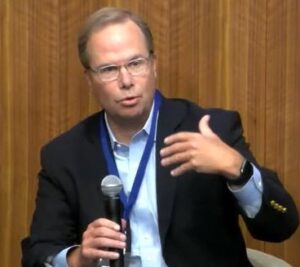Blockchain Creates Deeper, More Efficient Digital Networks that Expand Access to Capital

LiquidX CEO Jim Toffey spoke on “The Future of Capital Markets” at the Global Blockchain Business Council’s 4th annual Blockchain Central UNGA Conference September 16-17, 2021. The Global Blockchain Business Council (GBBC) is the leading industry association for the blockchain technology ecosystem and hosted the conference alongside the United Nations General Assembly (UNGA) as an official partner of the UN Foundation’s Global Goals Week.
Jim Toffey joined Michael Moro, CEO of Genesis Global Trading; Brendan Howe, Head of Blockchain at VMWare; Patrick Leary, Financial Crimes Risk Management at Wells Fargo; and moderator Reena Sahni, Partner at Shearman & Sterling LLP for a discussion that centered on the role of blockchain and distributed ledger technology to innovate and impact global capital markets.
“We are building an online digital network to connect people who need capital with people who have capital,” explained Jim Toffey. “There are very mature capital markets – for bonds and commercial paper for example – but the further you go downstream the more challenging it becomes. What is the asset if it is a piece of paper? How do you know it is real and what the other side knows? If you digitize the asset, both parties can be linked and agree on that asset.”
Several Fundamental Benefits
The presenters discussed how blockchain and Distributed Ledger Technology (DLT) can improve capital markets in several ways, including:
- Efficiency. A digital infrastructure enables a more efficient data sharing platform, with verified trusted data sources open to all. With one set of data for transactions and bookkeeping, each party does not need to maintain separate ledgers. Finance providers can work faster, expand their product offerings, and better service their customers. “In an online capital market, once identity and an asset are verified, the relationship changes from one-to-one to one-to-many. Borrowers can request funds from a group of lenders, receive quotes, and go straight to the transaction,” said Jim Toffey.
- Inclusion. Private, permissioned blockchain is improving the reach of capital markets to a broader range of participants. Purely decentralized architecture allows multiparty arrangements and reach that was previously not possible. “The pieces of the technology puzzle are coming together to allow for credit to be extended more quickly and to reach much further – creating a deeper, more liquid market,” said Jim Toffey. “For example, we work with companies that have ten thousand companies in their supply chain network. Any disruption can have a huge ripple. From a credit standpoint, this means that there are many suppliers downstream that need credit and capital to supply goods to the next person up the food chain. There are many finance options – Supply Chain, Accounts Receivable and Inventory Finance – but at the end of the day it is about extending credit and I see a much deeper network that connects the people that extend credit to those that need it.”
- Risk Reduction. With a decentralized, transparent network, banks and other counterparties will know their exposure to each other. Likewise, the Fed will also have a better view of risk in the system. With digital identity tools, Know Your Customer (KYC) checks can happen in real time and are less subject to fraud.
Yet, Challenges Exist
The group agreed that the pace of change will be gradual rather than sudden, like the early days of the internet when “everyone was trying to figure how things like the news and music would work on the new platform. Companies will figure it out as benefits become obvious,” said one panelist.
The main challenges impacting the rate of development include:
- Technology Stack. Blockchain and DLT is only one part of the puzzle. Several technologies must be put into place to enable fully digital capital markets, including tech that validates identity while maintaining privacy and security standards.
- Standards. A fully developed, digital capital market network will encompass many participants. Closed, single source solutions are not feasible at scale. Therefore, interoperability standards will need to be developed for all to access the market confidently.
- Regulatory Framework and Role of Traditional Banks. Laws and regulation will need to adapt to digital markets, and changes that boost the comfort of larger players. All major financial institutions are already looking closely at blockchain and DLT technology, and they will move faster once there is regulatory clarity.
When Will the U.S. Hit the Inflection Point?
As the largest financial marketplace in the world, the panelists agreed that capital to support the further development of blockchain and DLT will largely come from the U.S. However, on the implementation side, the U.S. may not be the leader due to tempo of regulatory change in this country. As one panelist stated, the U.S. has the most to lose due to its massive size, so it is not a bad idea to sit back and wait until best practices are evident.
Jim Toffey added, “I’ve been doing this for 30 years. In the beginning it seems like change is never going to come, and then boom – you hit an inflection point. A few years from now, people will have a hard time remembering what things were like before this big change. Over the next five years, I can see a dramatic shift in the capital credit network of trade, trade finance, and insurance as all these pieces come together.”
The Blockchain Central “Future of Capital Markets” panel and other presentations can be found below: